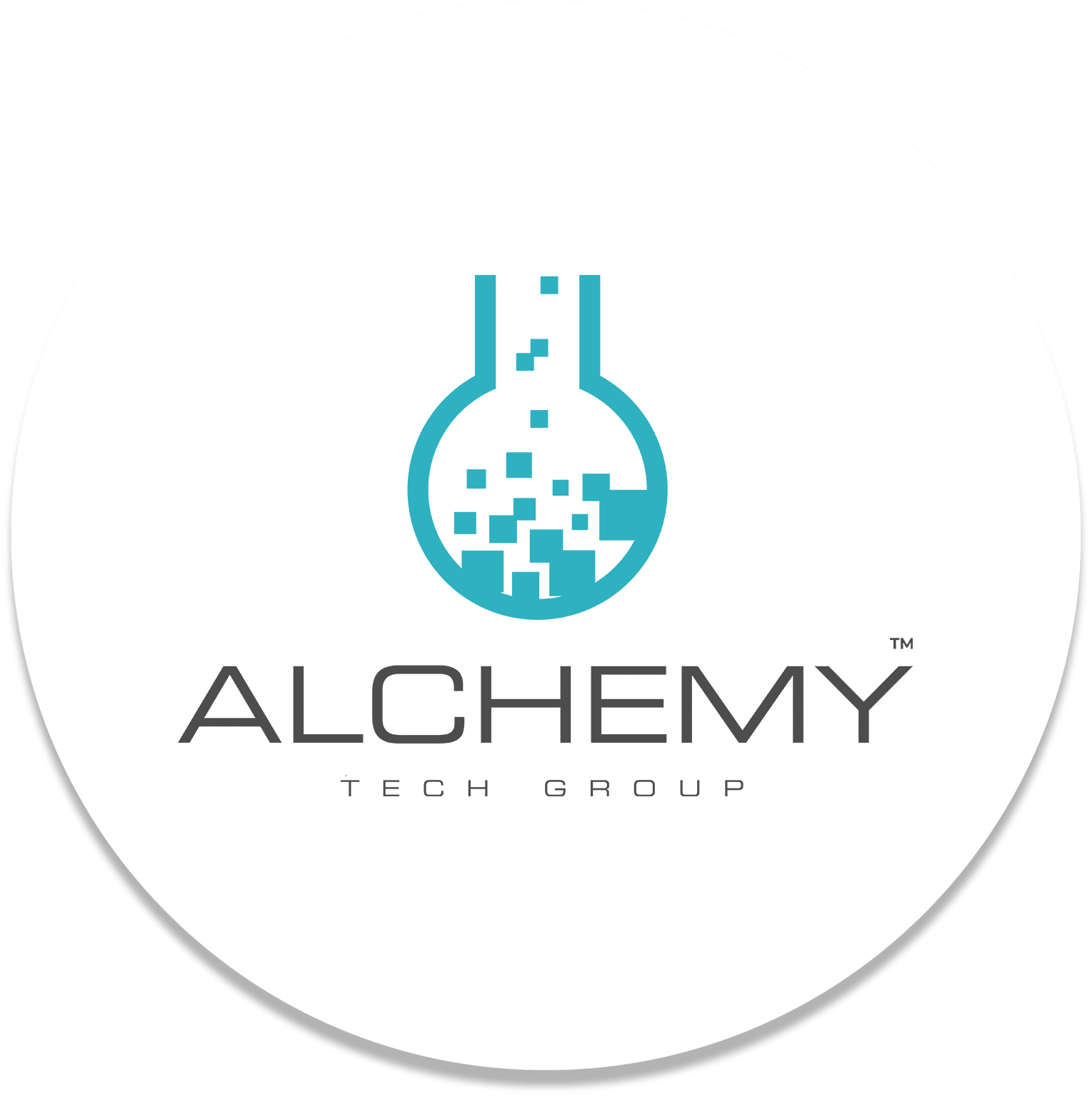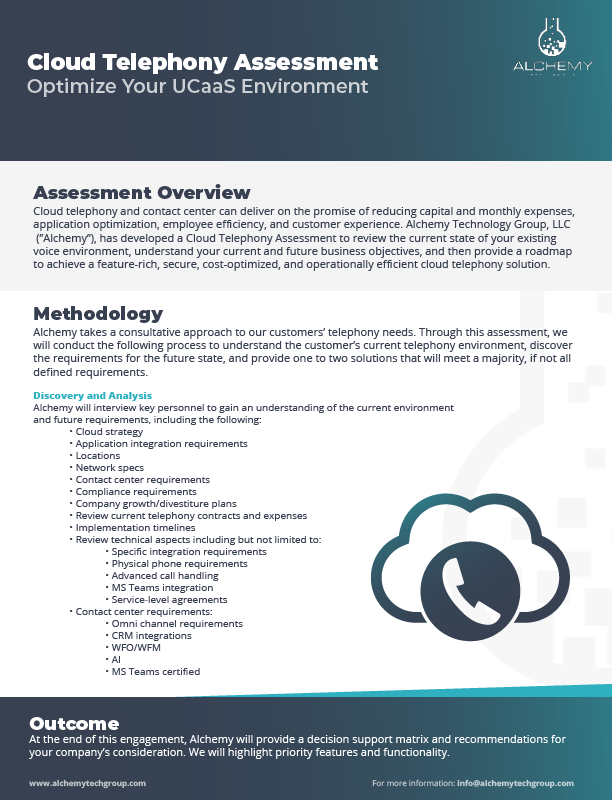Cloud Telephony Assessment
Let Alchemy Technology Group help you optimize your UCaaS & CCaaS Environment
Map Out Your Telephony Journey
Align and optimize your Unified Communications as a Service (UCaaS) and Contact Center as a Service (CCaaS) environments through the Alchemy Technology Group Cloud Telephony Assessment. At each stage, our approach is grounded on aligning your telephony infrastructure with business objectives. We examine your current system and future requirements, propose a solution, and provide a strategic roadmap to enhance your communication abilities to drive business success.
What is a Cloud Telephony Assessment?
This assessment is a comprehensive evaluation process that analyzes and identifies improvements your company’s cloud-based telephony infrastructure.
Alchemy’s Cloud Telephony Assessment helps:
- Identifies Inefficiencies: Pinpoint areas where the current system may be underperforming or overspending
- Aligns with Business Goals: Ensure the telephony system supports and enhances overall business objectives and growth plans
- Recommends Tailored Solutions: Offer specific solutions and a strategic roadmap to improve functionality, security, and cost-effectiveness

Schedule Workshop
Let’s talk about your cloud telephony plans. How can we help?
The Approach
1
We start with
Discovery
During the discovery process, we move quickly to understand the root of your problem, map out solutions, create estimates, and agree on scope.
Once all key players understand the problem being solved and their role in helping deliver the solution, we create a project plan that moves in terms of minutes and hours, not months and weeks.
2
Then we
Analyze
Alchemy’s approach involves a systematic evaluation of your telephony infrastructure, starting with detailed interviews with principal personnel to map the existing landscape and identify future growth opportunities, focusing on key areas:
- Strategic Analysis: Evaluating the overarching cloud strategy and how it integrates with current applications, assessing its alignment with the organization’s direction.
Technical Review: Examining network specifications and physical telephony infrastructure, including specifics like advanced call handling and MS Teams integration. This involves scrutinizing current telephony contracts and expenses for operational efficiency. - Compliance and Scalability: Ensuring the system adheres to compliance standards while adapting to company growth or restructuring plans.
- Service Delivery: Looking into service-level agreements to measure performance against expectations.
- Customer Interaction Analysis: Focusing on contact center dynamics, including omnichannel capabilities, CRM integrations, and leveraging AI to optimize customer engagement and support.
This approach offers a complete view of the current telephony system, enabling specific recommendations for improvements aligned with business goals.
3
End with an
Outcome
Upon completing the engagement, Alchemy will deliver a decision support matrix and tailored recommendations for your company, emphasizing key features and functionalities.
For the team: The team will benefit from streamlined decision-making, with clear guidance and prioritized recommendations for enhancing the telephony infrastructure.
For the business: The business will gain a strategically optimized telephony system, enhancing operational efficiency and aligning with long-term business goals.
Cloud Telephony Assessment
Maximize your business communications with Alchemy Technology Group’s Cloud Telephony Assessment, optimizing your unified communications system.

UCaaS stands for Unified Communications as a Service, which is a cloud-delivered model offering a variety of communication and collaboration applications and services. It typically includes voice and telephony, meetings, messaging, and presence information.
Conversational AI is a branch of artificial intelligence that enables machines to understand, process, and respond to human language naturally and conversationally. This technology is often used in chatbots and virtual assistants, allowing them to interact with users in a way that mimics human conversation.
PBX, VoIP, UCaaS, and CCaaS are related but distinct concepts in the telecommunications space:
PBX (Private Branch Exchange): A traditional telephone switching system that serves a private organization, permits sharing of central office trunks between internally installed telephones and provides intercommunication between those internal telephones within the organization without using external lines.
VoIP (Voice over Internet Protocol): A technology that allows telephone calls to be made over the Internet or other packet-switched networks. VoIP is a protocol that facilitates PBX features and can be used as part of a UCaaS or CCaaS offering.
UCaaS (Unified Communications as a Service): A service model where providers deliver different telecom or communications software applications or services, usually over the global IP network. UCaaS combines all the communication and collaboration tools into one platform, including voice, video, text, conferencing, and file sharing.
CCaaS (Contact Center as a Service): A cloud-based customer experience solution that allows companies to utilize contact center capabilities without the need to install, maintain, or upgrade hardware. CCaaS solutions provide tools for customer service agents to manage a multitude of customer interactions, including those via voice, text, social media, and more.
To summarize, PBX and VoIP are technologies focused on voice transmission, with PBX being a private network system and VoIP being a method of delivering voice communications over the internet. UCaaS is an all-encompassing suite that includes VoIP as part of a broader set of communication tools, while CCaaS focuses specifically on customer interaction and support services.
Conversational AI and generative AI can significantly enhance both UCaaS and CCaaS in several ways:
Improved Customer Interactions in CCaaS: Conversational AI, through chatbots and virtual assistants, can handle initial customer queries, provide instant responses 24/7, and escalate more complex issues to human agents. This improves customer satisfaction by reducing wait times and enhancing the quality of support.
Automated Workflows in UCaaS: Generative AI can automate routine communications, schedule meetings, and even generate reports or summaries from meetings, increasing efficiency and freeing up employees for more critical tasks.
Personalized Customer Experience in CCaaS: AI can analyze customer data to personalize interactions, predict customer needs, and offer tailored solutions, thereby enhancing the customer experience and potentially increasing sales or customer loyalty.
Real-Time Language Translation and Transcription in UCaaS: AI-driven language processing can provide real-time transcription and translation services, making communication seamless in a global business environment.
Enhanced Data Analysis in Both UCaaS and CCaaS: AI can analyze communication patterns, customer feedback, and service efficiency, providing valuable insights to optimize operations, improve service strategies, and make informed business decisions.
Intelligent Routing in CCaaS: AI can direct customer calls or messages to the most appropriate agent based on expertise, workload, or customer history, leading to more efficient case resolution.
By integrating conversational and generative AI into UCaaS and CCaaS, businesses can greatly improve their communication efficiency, customer satisfaction, and overall operational effectiveness.


